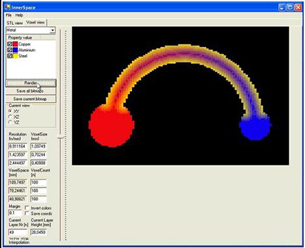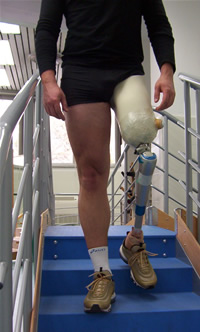Custom-Fit Products Begin with Human Body Geometries
Rapid manufacturing, information technologies and material science are combined to offer increased user comfort and time savings.
Latest News
February 26, 2009
By Susan Smith
 Multi Phase Topology Optimisation (MPTO), by IFAM, based on finite element analysis (FEA), is a numerical simulation technique. |
Custom-Fit (Ibi, Alicante, Spain), a European funded project coordinated by Delcam, that has been included in Sixth Framework Programme of the European Commission for a period of four and a half years, has developed a new, cost effective method to manufacture fully customized products. Some of the products that they have customized include a seat, trans-femoral prosthesis, knee implant, jaw implant and helmet.
Avoiding the need for molds, Custom-Fit has designed products beginning with body geometries, then employing a combination of rapid manufacturing, information technologies and material science.
Using 3D scans, designers capture geometrical characteristics, then data are used to form product shape with the use of CAD. Next the products are made, taking advantage of additive rapid prototyping technologies.
 InnerSpace, by TNO, allows a designer to define material property distributions and define the distribution profile. |
The demo for testing this manufacturing concept was the production of a trans-femoral prosthesis socket, which is the interface between the residual limb and the artificial leg. The socket’s main purpose is to enclose and protect the residual limb and to transfer forces from the residual limb to the prosthesis when the patient walks, stands or otherwise moves limbs. The prosthesis socket must be perfectly shaped to the patient’s residual limb, and must be comfortable, wearable and durable.
Involved in the Custom-Fit testing is Inail Centro Protesi, in Italy. The traditional way of manufacturing a prosthesis socket involves using a first male cast to thermo-form the first socket (referred to as the “check” socket) then this socket is tested by the patient and modifications are made using patient feedback. A second male cast is made to make the final socket. The socket is comprised of an inner soft thermo-formable layer covered by an outer composite structure. This process did not result in as accurate or comfortable a fit as the Custom-Fit process.
Using 3D CAD in the Custom-Fit technology process, designers can generate a first socket design, employing a set of measurements that are taken directly from the stump. Stereolithography is used to manufacture the check socket without having to build a first male cast.
After testing of the check socket, the shape is scanned using a probe scanner which then creates the inner surface. Materialise, a project partner, manipulates scan data files with an automated CAD tool to create the final socket design. The socket is then produced using Plastic Powder Printing (PPP), a rapid manufacturing process developed by Custom-Fit partner De Monfont University.
 Materialise also uses FEA to define a geometric model that is comprised of a large number of small scale volumetric elements. |
The Custom-Fit project has 31 partners from 16 European countries, a consortium that shares the objective of creating a technology system for “design, production and supply of customized products that improve user comfort.” Predicating in the project with a group of partners, the Instituto de Biomecánica de Valencia (IBV) defines the non-geometrical requirements for customized products. These requirements include the consideration of how the product feels on the user while it’s being worn. Also taken into consideration is the pressure distribution between the product and the person’s body.
In total, the Custom-fit consortium works with five different products, which involve different applications, environmental conditions and final users. In the first phase of the project, members were expected to identify the variables of each product for customization. This then led to the customization process of each product.
 Check Socket is manufactured with SLA process, employing DMX-SL which has good mechanical and thermoformability properties. |
In the beginning of the process of designing a part, product shape, user requirements, shape and mechanical properties are taken into account. Secondly, user-product interaction are considered, such as biomechanical and physiological features such as pressure, humidity, velocities and temperature. Anthropometric measurements such as shoe size, heel height, amputation side, stump exterior form, distance from joints to ground, user height and weight, anatomical angles, and distance between skeletal anatomical references. The performance of the product, any pain or discomfort and comfort levels are next in the evaluation. For the helmet design, features such as impact accelerations and inertial forces are taken into account, as well as microclimate, skin temperatures and internal temperature. Last of all, designers consider the customer’s overall emotional response to the product and their level of satisfaction.
The materials science aspect of the Custom-Fit project involves designing the products with multiple materials and a graded structure, which they have accomplished with verification of product designs with graded structures.
Experts worldwide have gathered to develop three design systems for representing products with graded structure. Graded material design, which offers better mechanical structure, is an emerging market. Custom-Fit’s objective with these software technologies is to integrate them with additive manufacturing processes so that they can produce products with a graded structure.
Three partners in the project are TNO from Netherlands, Fraunhofer-IFAM from Germany and Materialise from Belgium, have each defined a method to describe structural design of a product, each with a different philosophy. Until now, commercial CAD systems have not been able to describe an object’s material composition. Not only are these products able to define the graded structure, they can deposit the material properly.
 Check Socket is assembled and worn by patient and modified to his/her requirements. |
A description of each of the three softwares produced by these partners is as follows:
- InnerSpace, by TNO, allows a designer to define material property distributions and define the distribution profile. The source file for the software is STL and the STL model defines the outer boundary of the object. Material distribution can be defined for an entire object or for just a part of an object at various locations. Small data files make it very easy to transfer data.
- Multi Phase Topology Optimisation (MPTO), by IFAM, based on finite element analysis (FEA), is a numerical simulation technique. Its capabilities include being able to determine the best distribution of two or more different materials in components that are subjected to thermal and mechanical loads.
- Materialise also uses FEA to define a geometric model that is comprised of “a large number of small scale volumetric elements.” The designer can define countless properties to each element, and he/she can also define the type of material deposition used within each object.
More Info:
Custom-Fit
Ibi, Alicante, Spain
Inail Centro Protesi
Bologna, Italy
Instituto de Biomecánica de Valencia
Valencia, Spain
Materialise
Leuven, Belgium
TNO
The Netherlands
Fraunhofer-IFAM
Bremen, Germany
Susan Smith is a contributing editor for Desktop Engineering magazine. She has been an editor and writer for the technology industry for more than 15 years and resides in Santa Fe, NM. Send email about this article to [email protected].
Subscribe to our FREE magazine, FREE email newsletters or both!
Latest News
About the Author
DE’s editors contribute news and new product announcements to Digital Engineering.
Press releases may be sent to them via [email protected].






